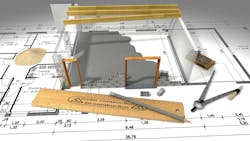Adopting a regenerative design mindset
To help address the current climate emergency, a new way of thinking across the entire architecture, engineering and construction industry is imperative. Part of the solution will require a holistic approach to design, one in which rather than doing less harm, design can positively contribute through regeneration. How do we adopt a regenerative design mindset and why is it important? We asked some of our leaders and here's what they had to say.
- Encouraging a Generation of "Architect-Activists" — Thomas Knittel
- Allowing Architecture to Fulfill Its Promise — Peter Duckworth-Pilkington
- The New Status Quo — Katie Sosnowchik
- A Vertically Integrated Philosophy — Jason Heinrich
- No Silver Bullets, But Many Opportunities — Lewis Morgante
- Take Reasonable Chances on Regenerative Innovations — Kate Diamond
Encouraging a Generation of "Architect-Activists"
The regenerative design framework represents a promising development in our architecture practice’s ambitious vision of fully embracing regenerative design. When used successfully, the framework can have real, practical impacts on our projects. For example, for one project I worked on, it revealed that peak asthma incidences aligned seasonally with harvest seasons and not with the usual contributors (socio-economic factors, urban living, industrial pollutants). As a result, we were able to exercise precaution, using natural ventilation via filtered mixed-mode over operable windows.
Although the regenerative design framework offers a pathway forward, there are barriers to adoption. The framework is highly technical in nature, and like similar frameworks such as the Living Building Challenge or LEED, it requires a rigorous adherence and an administrative overlay (and cost) to the project and client. We need both imagination and action on this front. We need successful, beautiful examples that inspire us. We need to commit to meeting or exceeding our own stated climate change ambitions.
My hope is that climate change, species eradication, water degradation and human health concerns will shift architects, clients and communities toward an 'urgency of now' and a greater understanding of the large, consumptive impact of the built world. I hope we will see an emergence of the next generation of 'citizen-scientists/architect-activists'!
Allowing Architecture to Fulfill Its Promise
Doctors take an oath to do no harm, architects don’t have as visceral a reminder of our professional responsibility. Nevertheless, we enjoy the privilege of a profession and with that, the responsibility to not just do no harm but to heal the communities that have entrusted in us. We owe it to the public to create designs that deliver recognized value to, and heal, the communities in which we build.
The global climate emergency has put the responsibility of the architect in clearer terms than ever before. Continuing to practice “business as usual” will literally threaten the continuation of our civilization and cause all too predictable human and environmental costs. We must change practice. And the power to change is in our hands, it is in the choices we make, the drawings we issue, and the specifications we write. And it is not just the right thing to do it is also an opportunity to create long-term value for both our clients and our profession all through regenerative design.
Regenerative design requires both architects and clients to shift mindsets from the narrow and the immediate to the expansive and long term. It requires holistic thinking that utilizes computer analytics and human creativity to see the true life costs of an asset on the capital, operational, environmental, and social sides of the ledger. Regenerative design builds real value for stockholders and stakeholders for our society and our environment. It is about seeing across silos for the win-win opportunities, to build back better.
The New Status Quo
For so long we’ve talked about designing buildings for zero impact, but regenerative design helps us think about ways buildings can contribute positively. Thinking about how buildings are able to give more than they take is an exciting new way to consider the built environment — and the critical role that architects, engineers and designers play in bringing about the change needed. I hope that this new way of thinking will change how buildings are designed forever — that regenerative design becomes the new status quo. How do we accomplish this?
Like the early days of the sustainable design movement, it starts with the client. Convincing the client that not only is it the right thing to do, but also the smart business thing to do. Companies need to be financially sound in order to be sustainable in the long-term from a dollars and cents perspective — we need to present the business case for regenerative design so that they understand that it supports their long-term strategy for success — economically, socially and environmentally. Decisions cannot be made in isolation. We need to harness market forces to achieve both environmental gains and attractive bottom lines.
Vertically Integrated Philosophy
Regenerative design is just that: design. It challenges us to go beyond meeting targets and efficiencies to find unique place-based design solutions for projects. For me, using and designing with mass timber is a clear choice, since most cross-laminated timber suppliers source and manufacture it within the province. But more exciting are integrating unique design moves, such as bioswales that integrate into the topography of a site and can collect onsite and offsite water to provide an overall benefit and regenerative impact to the community.
My hope is that regenerative design will permeate across disciplines so that planning, architecture, engineering, financing and operations of projects are committed to an inclusive design that seeks to make positive changes. I'm hopeful that supply streams will continue to adopt this lens as well. Architecture is only one facet of the design process. Regenerative design is a philosophy that needs to be vertically integrated from the economy down to the inhabitants.
No Silver Bullets, But Many Opportunities
Moving forward, energy considerations must be a driving force in our designs, whether it’s the operational energy of mechanical and electrical systems, embodied energy in the building structure and enclosure, or the waste involved in demolishing a building. Regenerative opportunities are highly dependent on where a building is, and what is going on inside. For example, projects can substitute a carbon-intensive concrete and steel structure with carbon-sequestering mass timber where it is available and locally sourced. Large, open sites can utilize a wellfield and ground-source heat pumps. The southwestern U.S. can produce much more electricity from solar photovoltaics than the same panels in the northeast. Buildings requiring high ventilation rates should incorporate airside energy recovery, and central utility plants with simultaneous heating and cooling loads will benefit from a heat recovery chiller.
Regenerative design requires that we embrace context-specific strategies to reduce energy consumption. Many of the processes used for years by building design professionals are not inherently regenerative, so any significant shift will require all of us to rethink what we do. There are no silver bullets for promoting regenerative design, but there are many opportunities for individuals and teams to carefully consider their options and incorporate regenerative strategies and products into their designs.
Take Reasonable Chances on Regenerative Innovations
Recognizing that our buildings, interiors and infrastructure projects have enormous impacts on global warming and the health of all life as we know it, I hope we all step up to urgently reduce our carbon footprints on every project. Seek not the minimum, seek what it takes to deliver regenerative design. Take projects beyond doing less harm to actually doing good – sequestering carbon, improving air quality, addressing environmental justice and equity. If clients are not asking for sustainability, then figure out how to deliver projects that simultaneously meet both your clients’ goals and your own responsibilities to design for our great grandchildren’s futures. It is far more important to do the right thing than to debate the science of climate change.
Achieving regenerative design goals requires new materials, means and methods; I am simultaneously blown away by the innovations being explored by startups and frustrated by the time it takes to get these innovations to market and appropriately scaled to truly impact our built carbon footprint. We need strategies for streamlining approvals, convincing not just early adopters but the entire market to take reasonable chances on breakthrough technologies, transforming the way we design, construct and operate our built environments.






